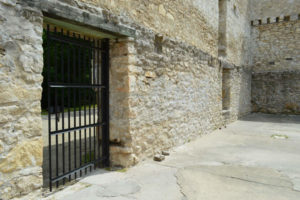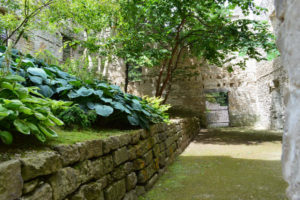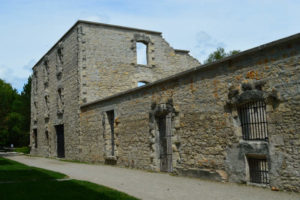Location
70 Norwich Street East, Guelph, ON, CanadaFeatures
Asphalt trails, Parking, Stonedust trail, Washrooms
Park features and amenities
- Downtown Trail (Trans Canada Trail) – stone dust and asphalt trail
- Goldie Mill ruins
- Parking
- Public washrooms at 75 Cardigan Street, adjacent to the ruins
Goldie Mill ruins
Goldie Mill is located in Goldie Mill Park at the northeast corner of Cardigan and Norwich streets and on the west bank of the Speed River in the city of Guelph. This three-storey limestone building, now a ruin, was constructed in 1866.
Goldie Mill facility bookings
Please review the 2021 Goldie Mills booking information document for information related to:
- Seasonal opening/closing dates;
- Fees;
- Booking specific information;
2021 Outdoor Booking Application
Schedules
Please note that these dates are subject to change due to COVID-19 and a minimum of 72 hours is required for processing new or additional booking requests.
- Saturday, May 1, 2021 – First day of Goldie Mill bookings.
- Sunday, October 10, 2021 – Last day of Goldie Mill bookings.
Fees
Please note that fees are based on 2021 rates and fees. Additional fees may apply depending on the details around your request. The minimum time to book is 2 hours.
- $53.49 + HST (per hour)
Please note: Wedding rental requests will be accepted for the 2021 and 2022 season. An application and damage deposit fee is due at the time of the booking.
City of Guelph Cancellation Policy
- Refunds are given to users that provide written notice at least 30 calendar days advance of the booked date.
- Refunds will not be given for rain or inclement weather.
- If cancelling a wedding request, the damage deposit fee will be refunded.
Special events
- If you are hosting a community or public event, please complete the special event application form.
- If you are requesting to have alcohol at your event, please complete the Alcohol Risk Management Policy Questionnaire.
- If you are requesting to film, please complete the Filming Permit Application.
- For an event attended by the public or event where you do not know each attendee, you are required to contact Wellington-Dufferin-Guelph Public Health at least 60 days prior to your event if you are serving food at a public event. This does not apply to private events where it will be attended by your invited guests only.
Features
- May be reserved for performances, weddings and other events
- Hydro is available
- Capacity: 160 persons
- Public washrooms at 75 Cardigan Street, adjacent to the ruins are closed; portable washrooms can be rented for special events.
Goldie Mill on Canada’s Historic Places website
Goldie Mill was designated, by the City of Guelph, for its historic and architectural value under Part IV of the Ontario Heritage Act (By-law (1983)-11323).
Heritage value
The former Goldie Mill site is one of the most historic manufacturing locations in Guelph. In 1827, David Gilkison, a cousin of Guelph’s founder John Galt, built a sawmill beside the Speed River. In 1845, doctors W. Clarke and H. Orton built the “Wellington Mills.” Shortly after a fire in 1850, the mills were rebuilt in stone and renamed the “People’s Mills.” After another fire, in 1864, the land was purchased by James Goldie, who enlarged and rebuilt the stone building, in 1866. As the owner of Goldie Mill, James was considered one of the leading flour manufacturers and dealers in Ontario, and served as president of the Ontario Millers’ Association.
The flour mills continued to expand and flourish under the direction of the Goldie family until sold in 1918. The mill continued to be operated until a spring flood in 1929 carried away the dam. A fire in 1953 completely destroyed the building, and it is now maintained as a ruin by the Grand River Conservation Authority.
In the 19th century, the manufacturing complex included a foundry, sawmill, cooperage, distillery, piggery and tannery. The diverse and long-time use of Goldie Mill contributed significantly to the growth and prosperity of Guelph. The mill has been characterized as a model flour mill in Canada.
Among the unique architectural features of the masonry construction of the thick stone walls are double-reinforced stone lintels, an unusual type of construction in Ontario. The most impressive remaining section of the structure was built in 1867 with quarry-faced limestone. All stone was quarried on the mill property.
The heritage designation covers all masonry construction, which survives after the 1983 stabilization project, the 90-foot brick chimney as well as the surrounding property as purchased by Grand River Conservation Authority in March 1976.
Legal description
Part of the Mill Lands on Cardigan Street and Part of the original bed of the River Speed, in the Canada Company’s Survey of the Town, now City of Guelph, and which may be also known as part of the Saw Mill Lot in Divisions “A” and “F”.
Designated portions
- The three-storey stone walls of the north-westerly section
- The two-storey stone walls of the Elevator Building (middle section)
- The brick chimney
- The riverside wall including ruins of the boiler room windows.
The remainder of the property is designated to include:
- Foundations which are buried to the north and northwest of the ruins
- River willows along the riverbank of the property
- Retention of other trees on the property is not required under this designation.
A chimney of swifts
The City of Guelph worked with the Ontario Ministry of Natural Resources and Forestry (MNRF) to relocate a pair of chimney swifts to Goldie Mill’s 90-foot tall chimney.




